Here are ten cities and towns that you need to visit in Trentino, Italy.
Trentino is an autonomous province in the north of Italy where both Italian and German are spoken.
It is a place of mighty mountains, deep valleys, and crystal-clear lakes. With its dramatic landscape and lush, unspoiled nature, Trentino seems very much plucked from a fairytale.
This is a land with a millennial history and a cuisine that is a mix of Tyrolean and Italian influences. It is a destination that is so worth visiting, especially if you want to escape the dense tourist crowds that besiege Italy’s tourist magnets like Venice, Rome, and Florence.
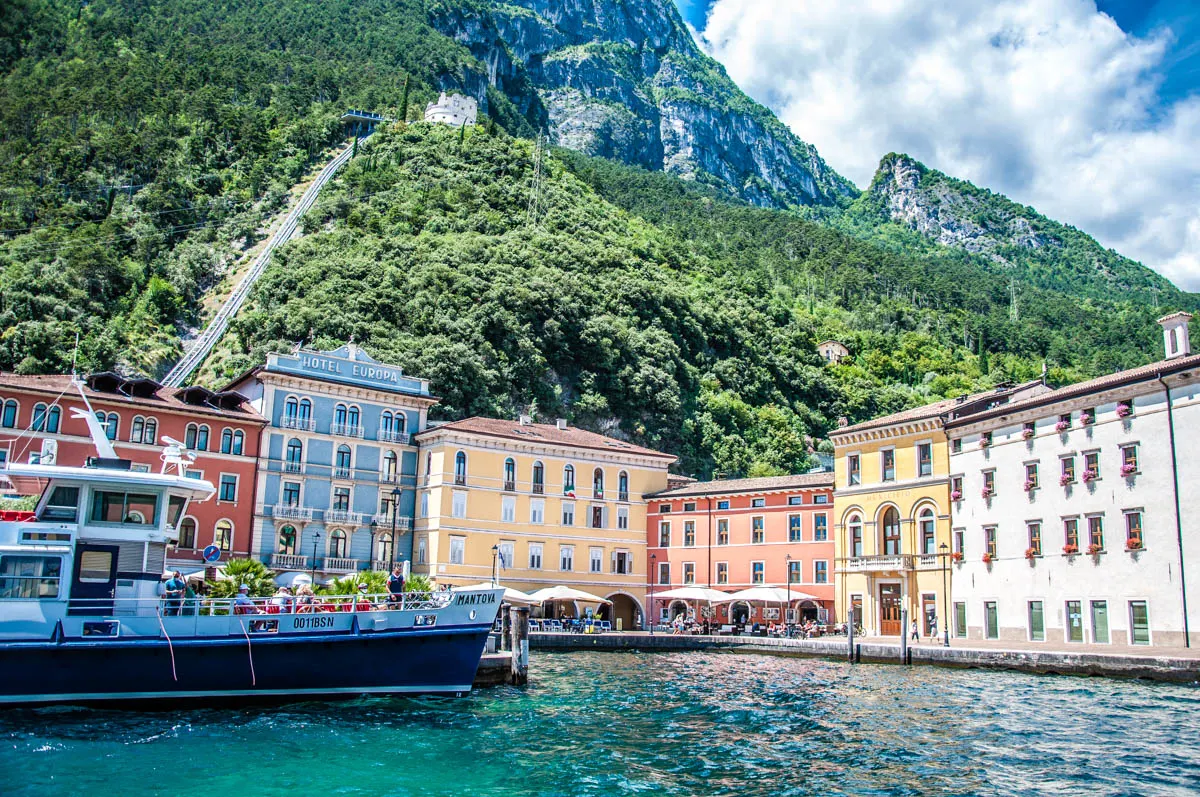
If Trentino sounds like a place where you would like to spend a break alternating some quality sightseeing with lots of fresh-air activities, then this list will come in handy. It introduces you to Trentino’s best cities and towns where you can base yourself to enjoy immediate access to the local landmarks, festivals, art, food, sports pursuits, and even spa facilities.
For each city and town in Trentino below, I have listed the best things to do there and insider tips to make your visit so much more enriching.
Several of these ten cities and towns in Trentino, Italy are very close to one another. For example, Riva del Garda (point 3 below) is right next door to Arco (point 4) and Nago-Torbole (point 8) and is also within an easy distance from Trento (point 1) and Rovereto (point 2). At the end of this blog post, there is a map showing you the exact location of each city and town. There is also a small section with some practical information and insider tips about travelling to and within Trentino, Italy. This way, you can easily plan day trips and see as much as possible during your Trentino holiday.
Over the six years that I spent living in Italy, I loved exploring Trentino time and time again. It is an absolutely beautiful corner of Italy which inspires you to see more, do more, eat and live better. It is my pleasure to share with you now everything I learned about Trentino’s best cities and towns. I hope that this blog post will come in useful when you are planning your own escape to Trentino, Italy.
Have a look!
10 Cities and Towns to Visit in Trentino, Italy (With Map, Photos, and Insider Tips)
1. Trento
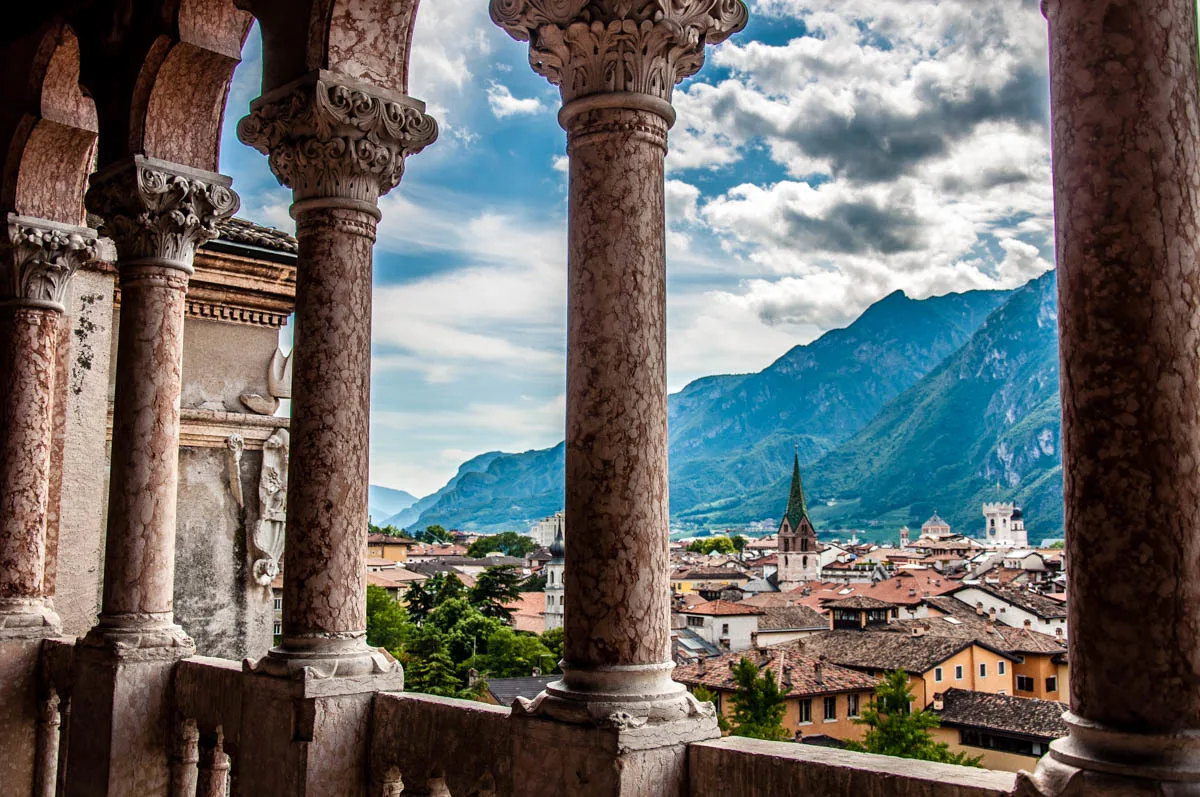
Trento is the capital of the Province of Trentino. Surrounded by lush nature, it is a beautiful city to visit, especially if you love history. This is where the Council of Trent was held in the 16th century starting the Catholic Reformation.
Here is a shortlist of some of the most interesting places you can see and visit in and around Trento in Trentino, Italy:
- Buonconsiglio Castle – this is an immense castle that was originally built in the 13th century and then it was enlarged several times. Most famously, this is where the Council of Trent was held. Nowadays the Buonconsiglio Castle hosts impressive archaeological and art collections. Make sure that you book in advance a visit to its Torre dell’Aquila to admire the stunning frescoes inside. Known as the Cycle of the Months, they date to the late Middle Ages and depict the rural activities that people engaged in throughout the year.
- Duomo – this is Trento’s imposing cathedral. It presents a striking mix of Romanesque and Gothic architecture and is dedicated to Trento’s patron and first bishop – St. Vigilius. Pay the small entrance fee to access the Duomo’s crypt. This is where you can see the remnants of a late-Roman basilica on top of which the cathedral was built between the 12th and the 13th centuries.
- Piazza Duomo – this is one of the loveliest squares in Italy. It stands right next to Trento’s Duomo. The piazza is surrounded by beautiful frescoed buildings. The 18th-century Fountain of Neptune is its crowning glory. Stop for a coffee and a pastry at one of the many cafes at Piazza Duomo. It’s a great spot for people- and architecture-watching.
- MUSE – this is a fantastic science museum that keeps both adults and kids happily entertained for hours.
- Orrido di Ponte Alto – this is a spectacular gorge with a 40-m tall waterfall hurtling through it. Click here to see a video I took standing on the bridge behind the waterfall.
Insider Tip:
Take the cable car from Trento up to the small village of Sardagna. The journey is brief but incredibly exciting as the small cable car zips you 400 m up in the air from the shore of the river Adige to the steep hill of Sardagna. Once there, you can go for a hike or simply enjoy the stunning views over Trento. Here is a video I took showing you what to expect.
2. Rovereto
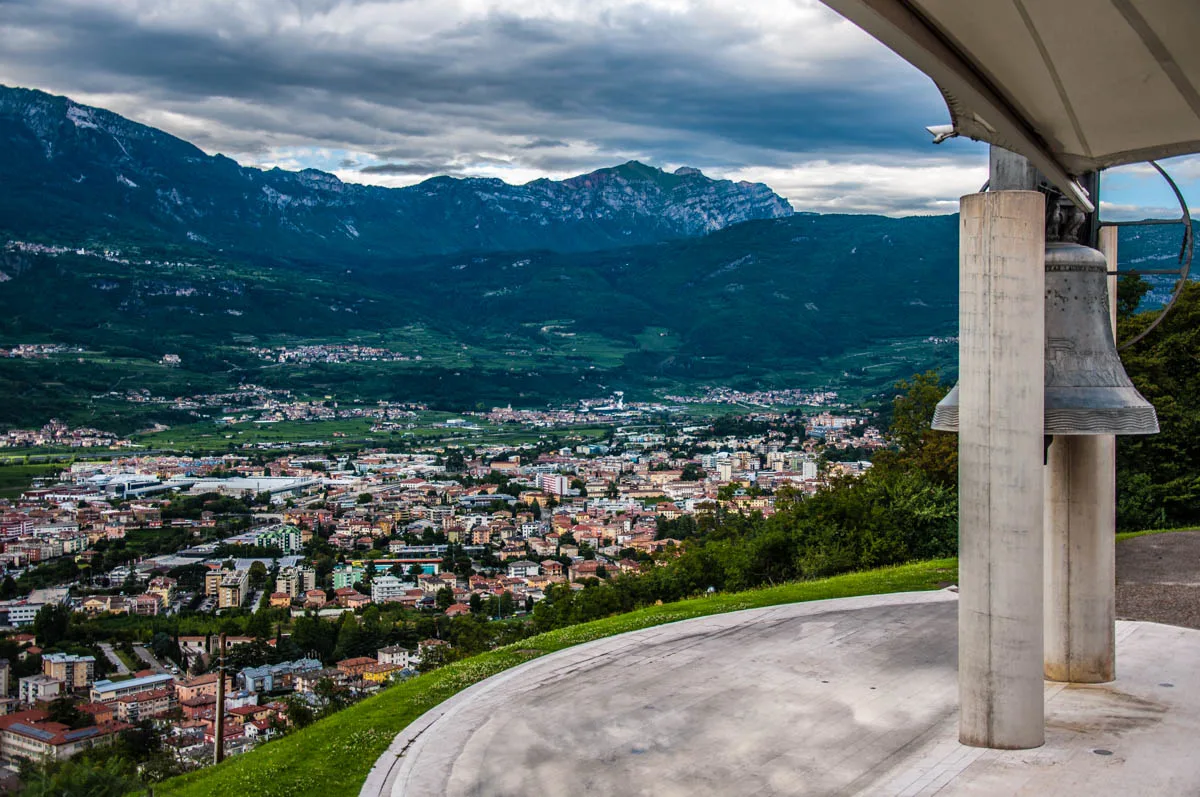
Rovereto is a hidden gem in the north of Italy. This beautiful city has deep layers of history, one of the best modern and contemporary art collections in Europe, and a picture-perfect historic centre. Rovereto is where the famous composer Mozart performed his first concert in Italy on Christmas Day 1769. Plus, Italy’s oldest coffee roasting company has been serving perfect cups of coffee since 1790 in Rovereto’s historic centre.
Here is a shortlist of some of the most interesting places you can see and visit in and around Rovereto in Trentino, Italy:
- MART – the Museum of Modern and Contemporary Art of Trento and Rovereto houses one of the most impressive art collections in Europe. (Almost) equally impressive is its building with its covered courtyard and wonderful architecture.
- Italian War History Museum – this is one of the largest and most important museums in Italy dedicated to the First World War and the act of war. It is housed in the 15th-century Castle of Rovereto. It is a very well-curated museum with a rich collection of artefacts. It is incredibly informative and in a way very emotional as it provokes so many questions in your head about the worst and the best in human nature.
- Depero’s Futurist Art House – Fortunato Depero’ was a futurist painter, writer, sculptor, and graphic designer. He grew in Rovereto and bequeathed to the city an incredible art collection counting over 3,000 pieces. A visit to the Futurist Art House was always a highlight for me when in Rovereto. Depero’s art is very impactful and the way he used shape and colour was way ahead of his time.
- Church of San Marco – this beautiful church stands on a sunlit square in the historic centre of Rovereto. It was built in the 15th century when Rovereto was within the confines of the Republic of Venice. Inside it, you can see the organ on which Mozart gave his first concert in Italy.
- Bell of the Fallen – this is the largest bell in the world to sound at full peal. It was cast in 1924 with bronze from cannons donated by all the nations that fought in the First World War. The bell was baptised with the name Maria Dolens. It stands on Colle di Miravalle – a hill with panoramic views over the city of Rovereto. Book a visit at dusk when the Bell of the Fallen rings 100 times in a salute to those who have fallen in war.
Insider Tip:
For a cup of some of the best coffee in Italy, head to Bontadi. This is a historic coffee shop right behind the Fountain of Neptune on Piazza Cesare Battisti in Rovereto’s historic centre. Founded in 1790, Bontadi is Italy’s oldest coffee roasting company. Nowadays, the company also runs a barista academy and has a small but incredibly interesting museum dedicated to all things coffee. The museum is just around the corner from Bontadi’s coffee shop in Rovereto and is a must-see, especially if you love coffee.
More Information:
3. Riva del Garda
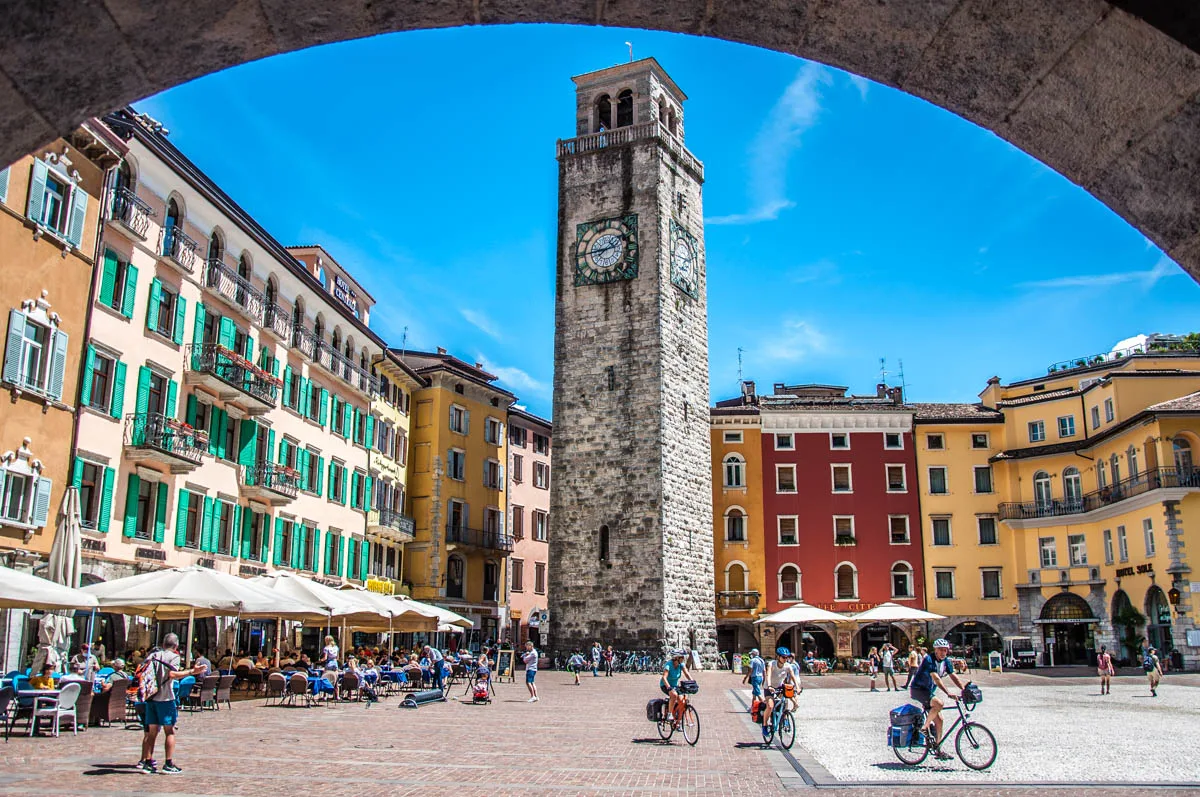
Riva del Garda is an elegant town on the northern extremity of Italy’s largest lake – Lago di Garda. This lakefront beauty has a splendid historic centre where Austrian influences mix with Italian flair. In the dramatic hills and mountains around, there are many hiking paths and dozens of opportunities to get active. Above all, Riva del Garda commands some of the best beaches on Lake Garda.
Here is a shortlist of some of the most interesting places you can see and visit in and around Riva del Garda in Trentino, Italy:
- Rocca di Riva – this is a medieval fortress that stands on a small artificial island in the historic centre of the city. It’s surrounded by water on all sides and a small bridge leads to its entrance. Nowadays the fortress is one of the two structures housing the exhibits of the Museum of Upper Garda. Spend time exploring the archaeological, historical, and art sections here for a deeper understanding of the history and traditions of this corner of Trentino, Italy.
- Torre Apponale – this is a 13th-century clocktower that dominates the skyline of Riva del Garda. Scale its 165 steps to admire panoramic views of the town and the lake from a height of 34 m.
- Bastione and Funicular – the Bastione is an early-16th century fort that stands above Riva del Garda on the slopes of Mount Rocchetta. A brand new panoramic lift transports you from the town’s historic centre up to the fort. The views are striking and you can continue to enjoy them from the bar and restaurant which nowadays operate inside the Bastione.
- Quartiere del Marocco – this is the oldest part of Riva del Garda. It dates back to the Middle Ages. The large houses here stand against the slopes of Mount Rocchetta.
- Mount Brione – this is the rocky hill that separates Riva del Garda from the neighbouring town of Torbole. We always joked that Mount Brione looked like someone had dropped a whole cake or a massive Oreo biscuit there and it half sunk into the lake while the other half got stuck almost upright in the air. A hiking path leads from Riva del Garda to the summit of Mount Brione. Up there you can enjoy fantastic panoramic views of Lake Garda and also see the forts that were built there between 1860 and the First World War.
- Cascata Varone – this is a stunning waterfall tumbling down inside a steep gorge. There are two viewing platforms – in the Lower Cave and in the Upper Cave – allowing you to admire the sheet of water crashing down the rocks. A beautiful natural park surrounds the caves and opens panoramic views over the northern extremity of Lake Garda.
Insider Tip:
Porta di San Giuseppe in the historic centre of Riva del Garda was once one of the oldest churches in town. The Church of San Giuseppe (also known as the Church of Disciplini) was erected in the 16th century at the place where a hermit had lived in the 13th century. It had marble altars and many works of art. In recent times, the church was deconsecrated and hollowed. Nowadays, it serves as a pedestrian crossing – a sort of tunnel on a crossroads in the historic centre of Riva del Garda. Its facade is preserved and inside you can see the church’s original pillars and a small, quite damaged fresco.
4. Arco
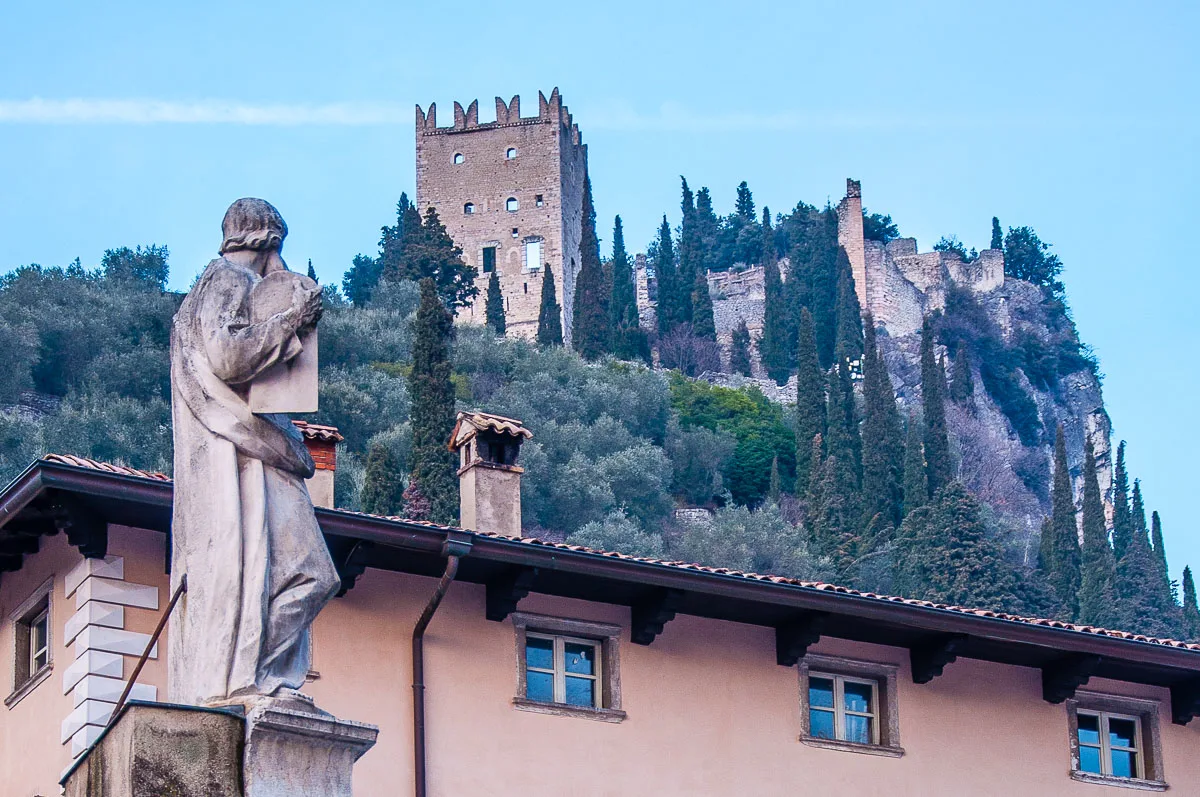
Arco is an elegant town just off the northern extremity of Italy’s largest lake – Lago di Garda. Surrounded by sheer limestone cliffs, Arco has a ruined castle and several beautiful churches and palaces. The town has a very Tyrolean feel to it and it is interesting to note that the Habsburg Court used to spend the summers here when this part of Italy was under the rule of the Austro-Hungarian Empire. Empress Sisi herself would come to Arco, too.
Here is a shortlist of some of the most interesting places you can see and visit in and around Arco in Trentino, Italy:
- Arco Castle – this is the ruined castle overlooking Arco from the top of a steep spur. Hiking up to the top is more than worth it as the views over the Sarca Valley and the northern extremity of Lake Garda are soul-inspiring.
- Galleria Civica Giovanni Segantini – you will find it in the 17th-century Palazzo dei Panni – one of the most beautiful buildings in the historic centre of Arco.
- Arboretum of Arco – a small arboretum and botanical garden with over 150 varieties of plants from all around the world. It’s free to visit.
- Lake Tenno – this is a small lake a short drive away from Arco. It’s famous for its turquoise colour. A hike around it takes about an hour. In summer, people sunbathe on its shores and take refreshing dips in its crystal-clear waters.
- Lake Ledro – this is another stunning lake near Arco. It’s very peaceful and quiet here. Plus, there is a small but very interesting museum telling the story of the stilt houses that once stood on the lakeshore. They were built by a pre-historic community.
- Maso Eden – a bio farm in Trentino. It has a herd of fluffy llamas and alpacas and it organises forest hikes in the company of these cute and (mostly) very good-natured animals.
Insider Tip:
Head to Canale’ di Tenno. Poised at 600 m above sea level, this small hamlet dates back to at least the early 13th century. Recognised as one of Italy’s most beautiful villages, Canale’ di Tenno preserves its original architecture. Tall houses made of stone and cobbled streets converge together to create a dreamy vision of times past. Canale’ di Tenno attracts artists from all over Italy and Europe and the village has a decidedly artistic feel to it. The local Casa degli Artists (House of the Artists) is where painters, sculptors, and other creators take residences throughout the year. Several festivals and a lively Christmas market take place each year here, too. Rango is another nearby medieval village to explore.
More Information:
5. Ala
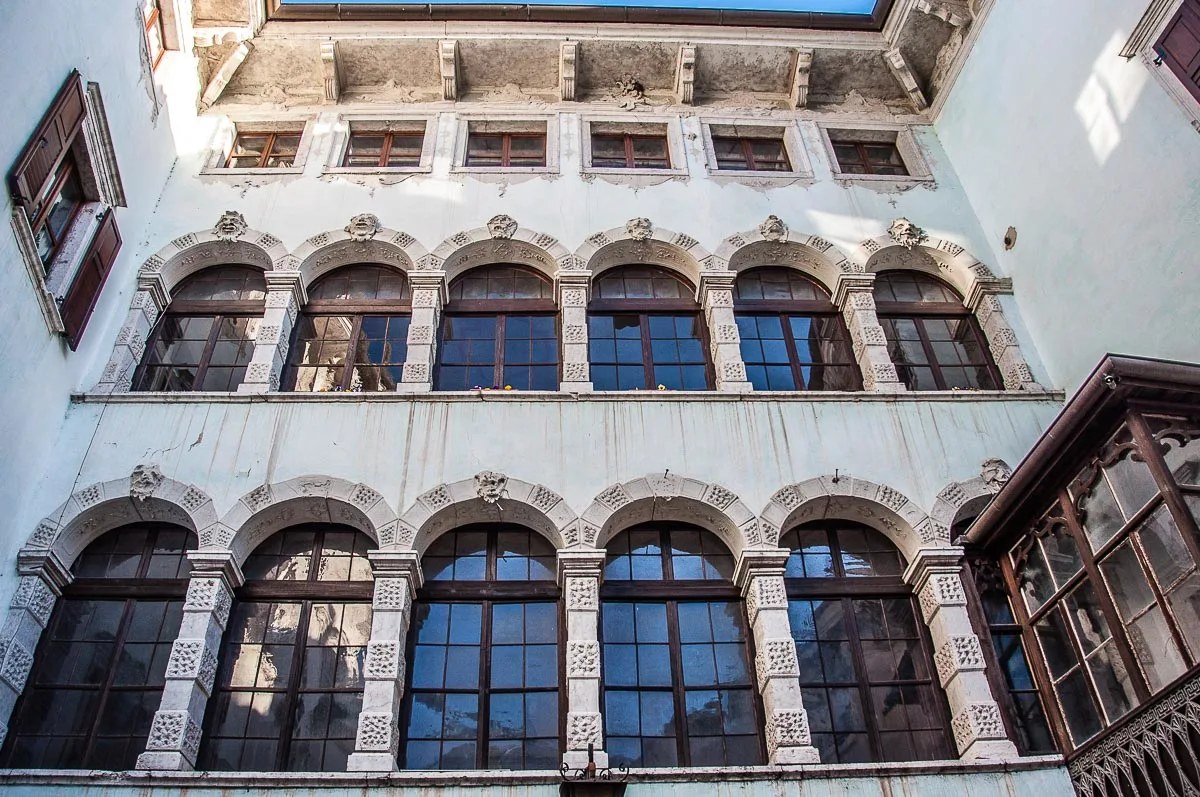
Ala is a cute little town with rich history and splendid Baroque palaces. Just a train stop away from Rovereto, it stands off the beaten track yet it has lots of stories to tell and hidden gems to explore. In the past, Ala was a rich merchant town famous all over Europe for the high-quality silk velvets that were produced here. Nowadays, the town keeps its heritage alive by staging large-scale events and a fantastic Christmas market each year.
Here is a shortlist of some of the most interesting places you can see and visit in and around Ala in Trentino, Italy:
- Baroque Palaces – these are beautiful large buildings with Baroque architecture and decoration. They were built with the proceeds from the sale of the silk velvets made in Ala in the 17th and 18th centuries. At Christmas each year a large Christmas market is staged all throughout Ala. The stalls of local artisans and makers take over the town’s Baroque palaces.
- Historic centre – Ala has one of the best-preserved historic centres in Trentino, Italy. Expect cobbled streets and an authentic atmosphere.
- Museo del Pianoforte Antico (Antique Piano Museum) – you will find this unique museum in the Palazzi de’ Pizzini. Here you can see beautiful pianos played by Mozart, Beethoven, Chopin and Schubert. The Palazzi de’ Pizzini is a complex of two palaces and a large house. Many famous people have spent the night here during their time in Ala, Trentino. Among them are Mozart and Napoleon Bonaparte.
- Citta di Velluto – City of Velvet is a large event held each year in July. This is when Ala returns to the 17th century and reenacts its period of maximum splendour. Expect people dressed in Baroque costumes all over town.
- Sanctuary of San Valentino – this is a Baroque church dedicated to St. Valentine who is highly venerated in and around Ala.
Insider Tip:
Combine your time in Ala with a visit to the nearby Avio Castle. This is one of the oldest fortresses in Trentino and it’s famous for its frescoes on the themes of love and war. The crenellated walls of the castle and its sturdy keep will make you feel like you have been transported back to the Middle Ages. The lush garden is where many events are staged at regular intervals throughout the year. A must-see!
6. Levico Terme
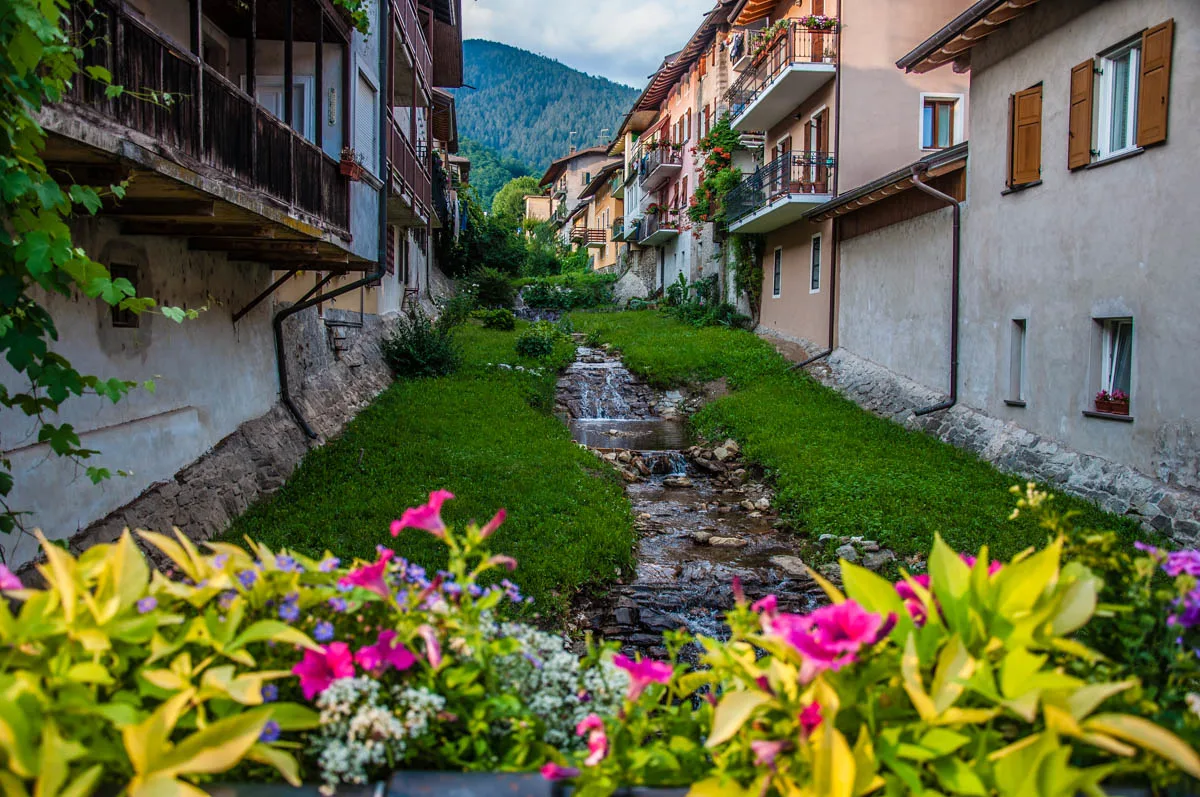
Levico Terme is a very pretty town on the shores of Lake Levico in Trentino, Italy. It is famous for the local thermal waters. They feed the town’s many thermal baths and spa hotels. Levico Terme has a postcard-perfect town centre and it is surrounded on all sides by lush nature. Lake walks, hiking paths, ski pistes, chairlifts, there are so many options to keep active here.
Here is a shortlist of some of the most interesting places you can see and visit in and around Levico Terme in Trentino, Italy:
- Habsburg Park – this is the largest historic park in the Province of Trento. In winter, it hosts Levico Terme’s famous Christmas market. 76 tree varieties and 125 species of shrubs grow here.
- Lake Levico – this small and beautiful lake is right next door to Levico Terme and shares a name with it. You can go for a circular walk around the lake or enjoy a spot of sunbathing and swimming on a hot day.
- Lake Caldonazzo – this is Trentino’s largest lake. It has beautiful clean beaches. Its water is very warm in summer and it’s a great place to practise all sorts of water sports.
- Valsugana – this is the long and wide valley where Levico Terme is located. It starts from just after the provincial capital of Trento and extends to where the Province of Trentino meets the Province of Vicenza. Valsugana is also the valley where the important for Northern Italy River Brenta is born from the waters of Lake Caldonazzo and the nearby Lake Levico. Apple orchards, raspberry nurseries, and verdant vineyards dot the valley’s plains and hills. It’s very pleasant to travel through it taking in the mighty shapes of the mountain chain of Lagorai and the peaks of the chain Cima XII-Ortigara. Medieval castles and ruins can be glimpsed here and there adding to the rustic fairytale feel of the landscape.
- Panarotta 2002 – a popular ski resort about 10 km away from Levico Terme. It has three chairlifts, a ski school, and a ski rental.
- Arte Sella – this is a contemporary art gallery that is set up in a forest. Each work of art blends and contrasts with its natural environment. You hike from one to the next following a trail through the tall lush trees.
- Fort Verle and Fort Vezzena – these are Austro-Hungarian forts that were built at the start of the 20th century. This part of Trentino is dotted with old forts. They are very interesting to visit so as to learn first-hand about the complicated history of this corner of Italy.
Insider Tip:
Terme di Levico is a large spa centre famous for its thermal spring waters with therapeutic properties. The spa season here runs from April to November.
More Information:
- Lake Caldonazzo, Italy – 10 Things to Do Around Italy’s Largest Lake
- 8 Lakes in Trentino, Italy You Have to See for Yourself (With Map and Practical Tips)
7. San Martino di Castrozza
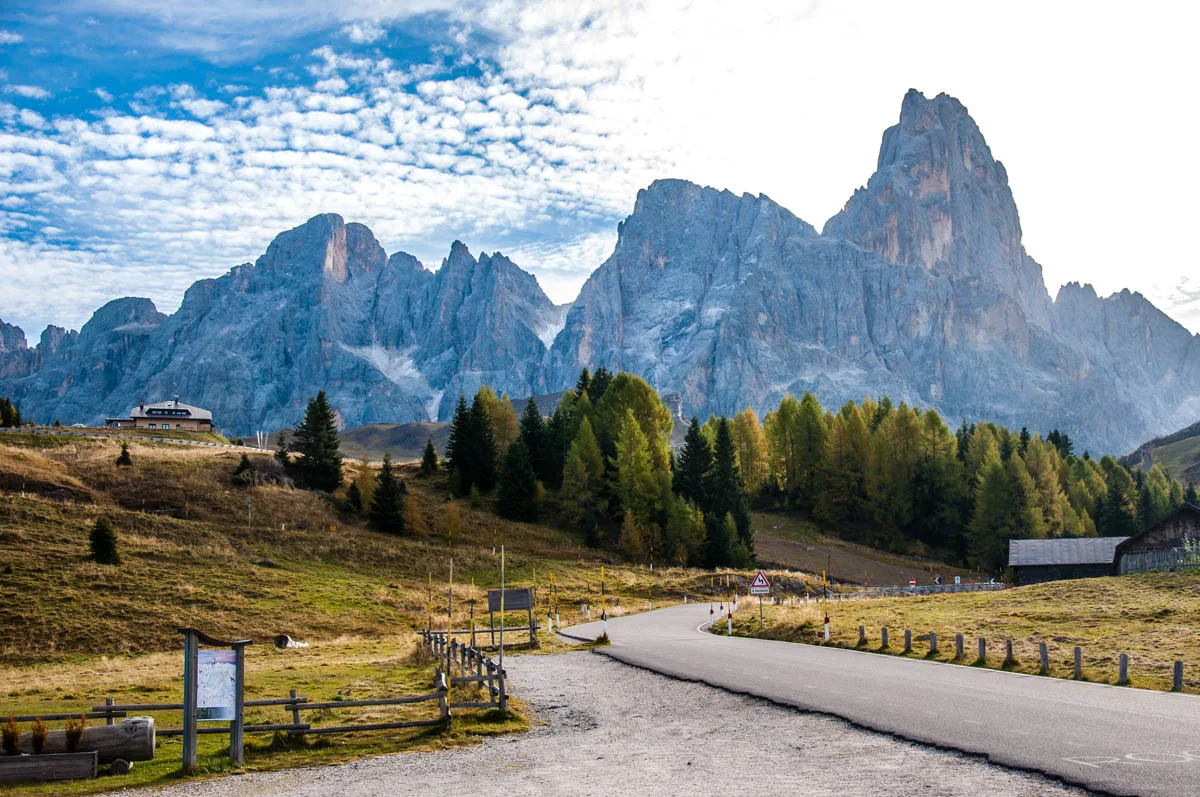
San Martino di Castrozza is a beautiful town in Trentino, Italy. In winter it becomes a bustling ski resort. The town is named after St. Martin – the Roman soldier who gave his cloak to a beggar. Castrozza is a corruption of the Latin word castrum meaning a Roman fortress or Roman encampment.
Here is a shortlist of some of the most interesting places you can see and visit in and around San Martino di Castrozza in Trentino, Italy:
- Pale di San Martino – this is the largest mountain group in the Dolomites. Its jagged rocky peaks feature in many iconic photos of this corner of Italy. Curiously enough, the peaks were once coral reefs at the bottom of a shallow sea! This could explain why they turn a lovely pink colour every day at sunset. Together with Paneveggio, Pale di San Martino forms a large natural park.
- Paneveggio Forest – this is a beautiful ancient forest populated by tall red spruce trees. The trees produce perfect tonewood which is particularly prized. Legend has it that fabled luthiers like Antonio Stradivari and Nicola Amati personally sourced the tonewood for their priceless violins from Paneveggio.
- Small Dairy Farms – driving and hiking around San Martino di Castrozza, you will come across many small dairy farms. Known as malga in Italian, they produce wonderful local cheeses. Plus, many of them also function as restaurants serving delicious local dishes. A special mention deserve Agritur Malga Rolle.
- Colbricon Lakes – these are two small lakes surrounded by mountain peaks in the heart of the Paneveggio-Pale di San Martino Nature Park in Trentino, Italy. You can only reach them on foot. The most popular hike to the lakes starts from Agritur Malga Rolle – an alpine dairy farm with a great restaurant. Walking to the lakes is very pleasant and it takes you through lush forests. With an elevation of 120 m, the hike is easy enough for families with small kids and anyone who loves moving and nature. Archaeological excavations around the Colbricon Lakes have revealed artefacts from Paleolithic and Mesolithic tribes who would spend each summer there 12,000 years ago.
- Vanoi Valley – this is a beautiful area which is known as the Green Heart of Trentino. Its lush landscapes and small villages charm the soul. The Vanoi EcoMuseum explores the history and traditions of this unspoilt green paradise.
Insider Tip:
Drive the short distance from San Martino di Castrozza to the Visitors’ Centre Terra Foresta of Paneveggio. It is right in the heart of the Violins’ Forest and has a large car park behind it. Leave the car there and go for a lovely walk through the forest following the Sentiero Marcio’. It’s suitable for all ages and it’s a very beautiful hiking path. Among its many highlights are a Tibetan bridge and also a deer enclosure. A program aiming to reintroduce deer to Paneveggio has been operating for several decades now. The large enclosure is where the animals spend the first year of their lives before being released into the wild.
More Information:
- Paneveggio – Exploring the Violins’ Forest in the Dolomites, Italy
- 8 Lakes in Trentino, Italy You Have to See for Yourself (With Map and Practical Tips)
8. Nago-Torbole
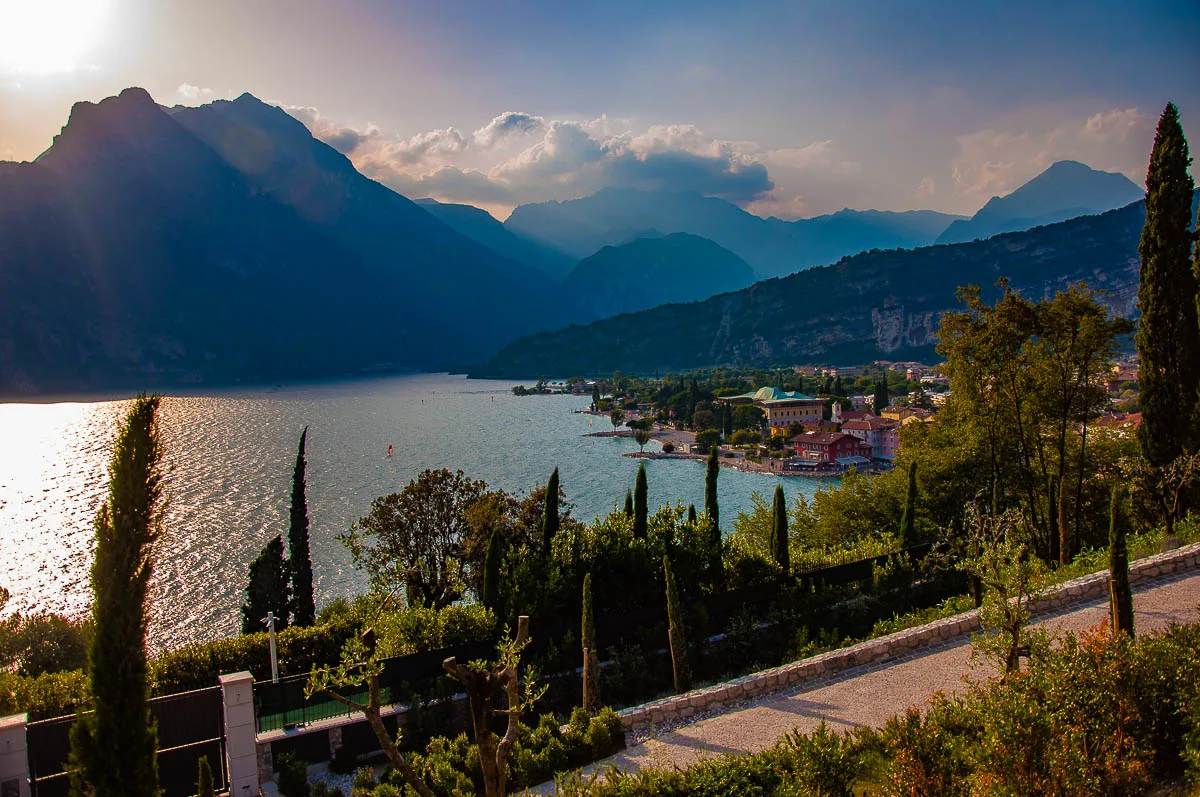
Nago and Torbole are two small towns in Trentino, Italy. As they are right next to one another, nowadays, they are hyphenated and referred to as one. Nago is just above the northern extremity of Lago di Garda – Italy’s largest lake. Torbole is on the lakefront. Both are really cute and a great place to visit if you want to relax surrounded by beautiful nature, sunbathe on the lake’s beaches, engage in some world-class windsurfing and sailing, or hike to structures of natural and historic interest.
Here is a shortlist of some of the most interesting places you can see and visit in and around Nago-Torbole in Trentino, Italy:
- Lakefront Historic Centre of Torbole – expect a wonderful mix of pastel- and brightly-coloured houses offset by the sparkling teal waters of Lake Garda. A special mention here deserves the Old Customs House which was built in the 18th century on the edge of the small harbour. A truly picturesque place!
- Penede Castle – this is a ruined castle with centuries-old history. It offers fantastic panoramic views over Lake Garda.
- Busatte-Tempesta Panoramic Path – a truly unique hiking path above Lake Garda. Part of it includes metal staircases with 400 steps in total. It feels like you are hanging above the lake and the views are simply stunning.
- Navene Beach – there are many beaches in and around Torbole on Lake Garda. I particularly love the one at Navene, which is a short driving distance further away from the town. Curved around a small bay, the pebbly beach of Navene has it all. Picnic tables in the shade of an olive grove, a small playground to keep the kids happy, a floating platform to challenge you to swim across to it, a pair of resident swans and a gaggle of ducks, large fish that you can see swimming in the water, plus a couple of benches on the beach to comfortably sit and admire the gorgeous views.
Insider Tip:
Head to Marmitte dei Giganti – enormous potholes which were formed when a massive glacier over 1,000 m high slid down from the mountains. The waters from the melting of the glacier rushed through the crevasses in it as powerful waterfalls. They hit the rocks underneath causing a strong swirling of pebbles and stones. This eroded the soft limestone rocks and created the steep cavities of the potholes. You will find Marmitte dei Giganti right next to the panoramic road which leads from Torbole up to Nago. The small car park next to the potholes has fantastic views over the lake and the surrounding mountains. Just bear in mind that to reach the Marmitte dei Giganti from the car park, you’ll need to walk a short distance along the busy road and there is no pavement there. So, exercise utmost caution!
9. Borgo Valsugana
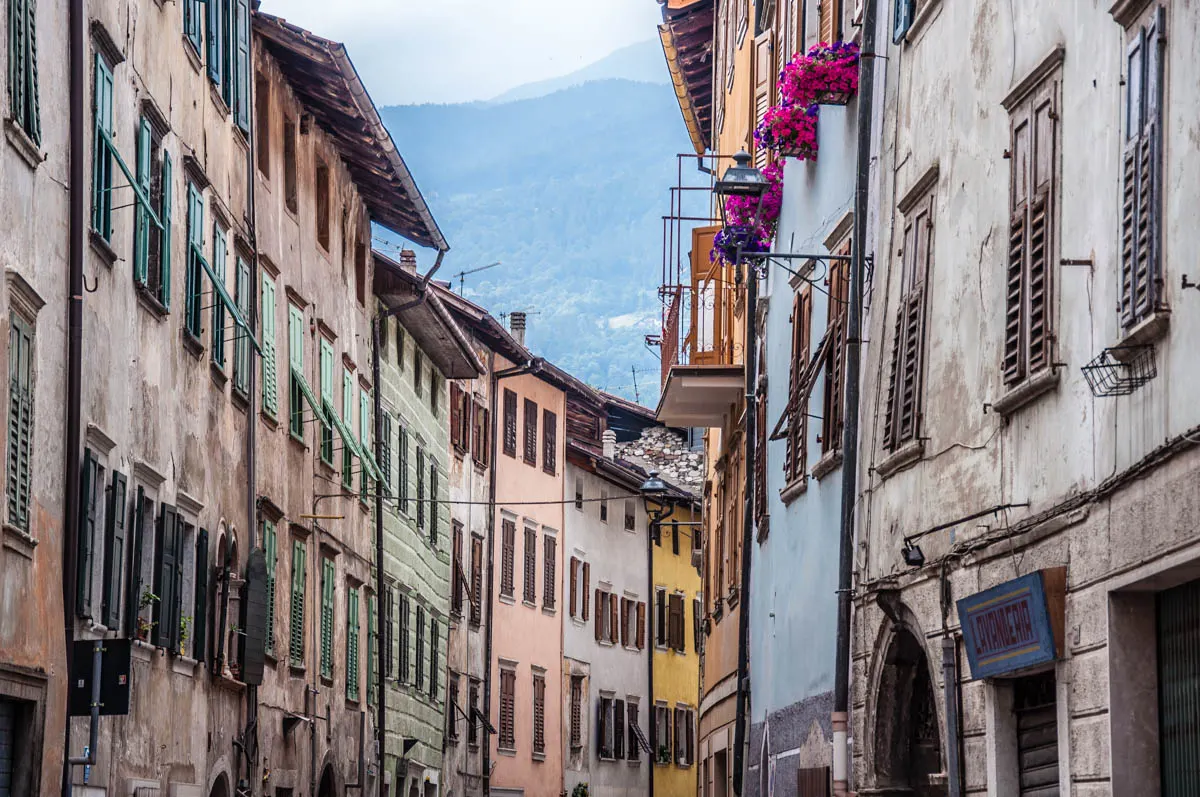
Borgo Valsugana is a small town in the Valsugana Valley in Trentino, Italy. The River Brenta flows through its historical centre and the striking Castel Telvana (not open to the public) crowns a lush hill above the town. Borgo Valsugana has ancient origins. It was established on Via Claudia Augusta – an important Roman road that connected what nowadays is Northern Italy to Central Europe.
Here is a shortlist of some of the most interesting places you can see and visit in and around Borgo Valsugana in Trentino, Italy:
- Historic Centre of Borgo Valsugana – go for a walk along the main street – Corso Asugum – here and visit the town’s churches, the Great War Museum, and several other local landmarks. I especially enjoyed looking at the crystal clear waters of the River Brenta and the historic houses on its shores.
- Valsugana – this is the long and wide valley where Borgo Valsugana is located. It starts from just after the provincial capital of Trento and extends to where the Province of Trentino meets the Province of Vicenza. Valsugana is also the valley where the important for Northern Italy River Brenta is born from the waters of Lake Caldonazzo and the nearby Lake Levico. Apple orchards, raspberry nurseries, and verdant vineyards dot the valley’s plains and hills. It’s very pleasant to travel through it taking in the mighty shapes of the mountain chain of Lagorai and the peaks of the chain Cima XII-Ortigara. Medieval castles and ruins can be glimpsed here and there adding to the rustic fairytale feel of the landscape.
- Lake Caldonazzo and Lake Levico – just a short distance away from Borgo Valsugana, you can visit two of the most interesting and beautiful lakes in Trentino, Italy. Lake Caldonazzo is also Trentino’s largest lake and is especially lovely as its water is very warm in summer. Lake Levico is small and compact and is a great destination for a full circle, lakefront walk.
- Arte Sella – this is a contemporary art gallery that is set up in a forest. Each work of art blends and contrasts with its natural environment. You hike from one to the next following a trail through the tall lush trees.
Insider Tip:
If you can, try to visit Borgo Valsugana at the end of July. This is when the famous Palio delle Zattere (in English, race of the rafts) takes place in town. In the past, the zattere were wooden logs that would be sent floating from the mountains down the River Brenta all the way to Venice. There, they would be used in the construction of the lavish Venetian palaces. The Palio nowadays recreates this ancient tradition. Teams from the different neighbourhoods (locally called contrade) of Borgo Valsugana dress up in medieval garb. Then they compete with one another by sailing upright on tiny rafts down the River Brenta.
More Information:
- Lake Caldonazzo, Italy – 10 Things to Do Around Italy’s Largest Lake
- 8 Lakes in Trentino, Italy You Have to See for Yourself (With Map and Practical Tips)
10. Fiera di Primiero
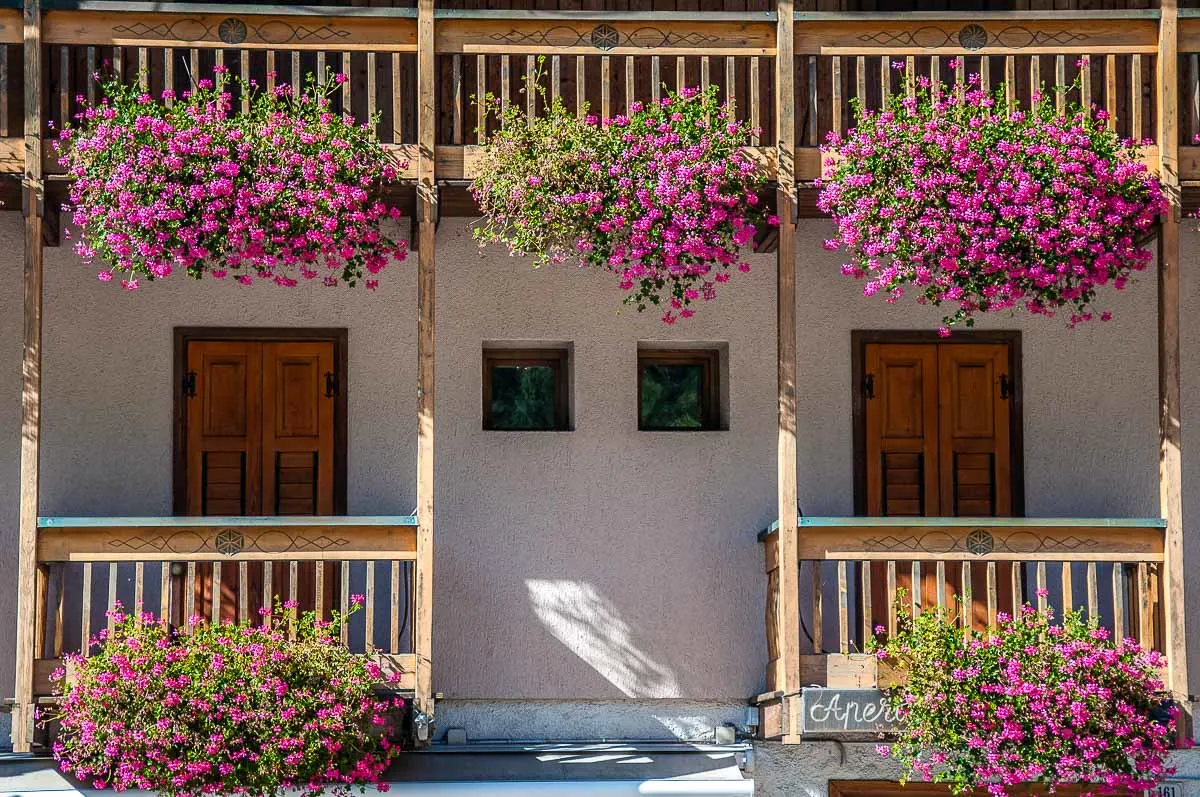
Fiera di Primiero is a small town in Trentino which is a great destination if you love the outdoors. Its houses are dotted around the lush valley of Primiero in the shadow of the Pale di San Martino – the biggest mountain group of the Dolomites and a UNESCO World Heritage Site. In the 15th century, the town was part of the Austrian Empire and hosted the most important fair in the whole valley. Hence its name (as fiera in Italian means fair). Most notably, Luigi Negrelli – the first planner of the Suez Canal – was born here in 1799.
Here is a shortlist of some of the most interesting places you can see and visit in and around Fiera di Primiero in Trentino, Italy:
- Church of Santa Maria Assunta – this is one of the most beautiful churches to visit in the whole of Trentino. Its large frescoes are particularly famous.
- Palazzo delle Miniere (also known as Palazzo del Dazio) – this is a large 15th-century building that nowadays hosts important documentation and exhibits about Primiero’s history and traditional crafts. From weaving and spinning to cheese-processing and haymaking, you can find a lot of information here about the local rural activities. Special attention is given to the copper, silver, and iron mines that existed in Primiero during the Late Middle Ages.
- San Martino di Castrozza, Passo Rolle, and Passo Cereda – visit this beautiful area of Trentino, Italy to ski in winter and to hike and engage in a number of outdoor activities in summer. A special mention here deserve the delicious cheeses produced by the local small dairy farms (called malga in Italian).
- Mezzano Romantica – this is one of the most beautiful villages in Italy. It’s famous for its woodpiles which have been elevated to art installations. A new woodpile is added each year and visitors are invited to walk around the village to try and spot all of them.
- Paneveggio-Pale di San Martino -a large nature park that is a UNESCO World Heritage Site. The red spruce trees that grow in the Paneveggio forest are especially prized for their perfect tonewood. Legend has it that fabled luthiers like Antonio Stradivari and Nicola Amati personally sourced the tonewood for their priceless violins from Paneveggio.
Insider Tip:
Tosella is a fresh curd cheese that was first invented in the Primiero Valley. Give it a try when you are in Fiera di Primiero. It’s delicious quickly pan-fried, grilled or roasted.
More Information:
Map of the 10 Cities and Towns to Visit in Trentino, Italy
Discover ten beautiful cities and towns to visit in Trentino, Italy. Click on each pin on the map for local accommodation options.
Practical Information about Visiting Trentino in Italy
1. Where is Trentino, Italy?
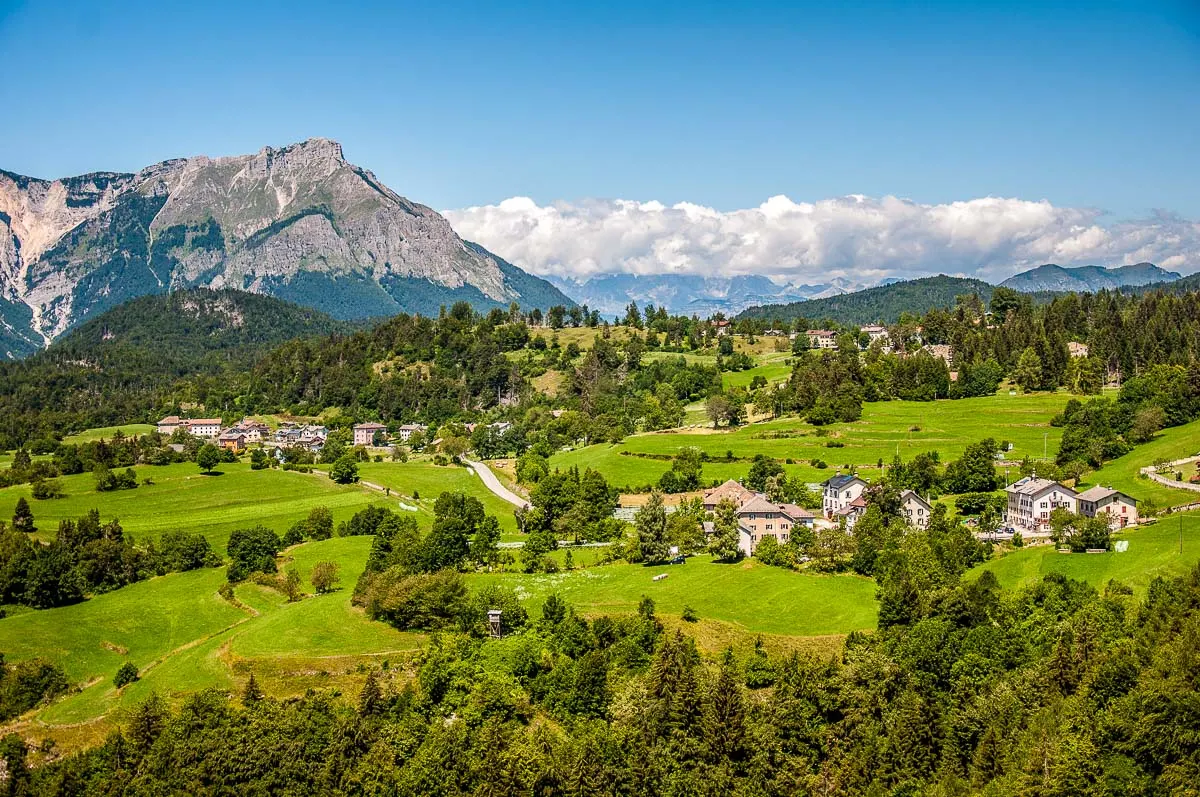
Trentino is an autonomous province in northern Italy. It borders the regions of Lombardy to the west and Veneto to the south. To the north, it borders the autonomous Italian province of South Tyrol (known as Alto Adige in Italian). Together Trentino and Alto Adige form the autonomous Italian region of Trentino-Alto Adige.
2. How to travel to Trentino, Italy?
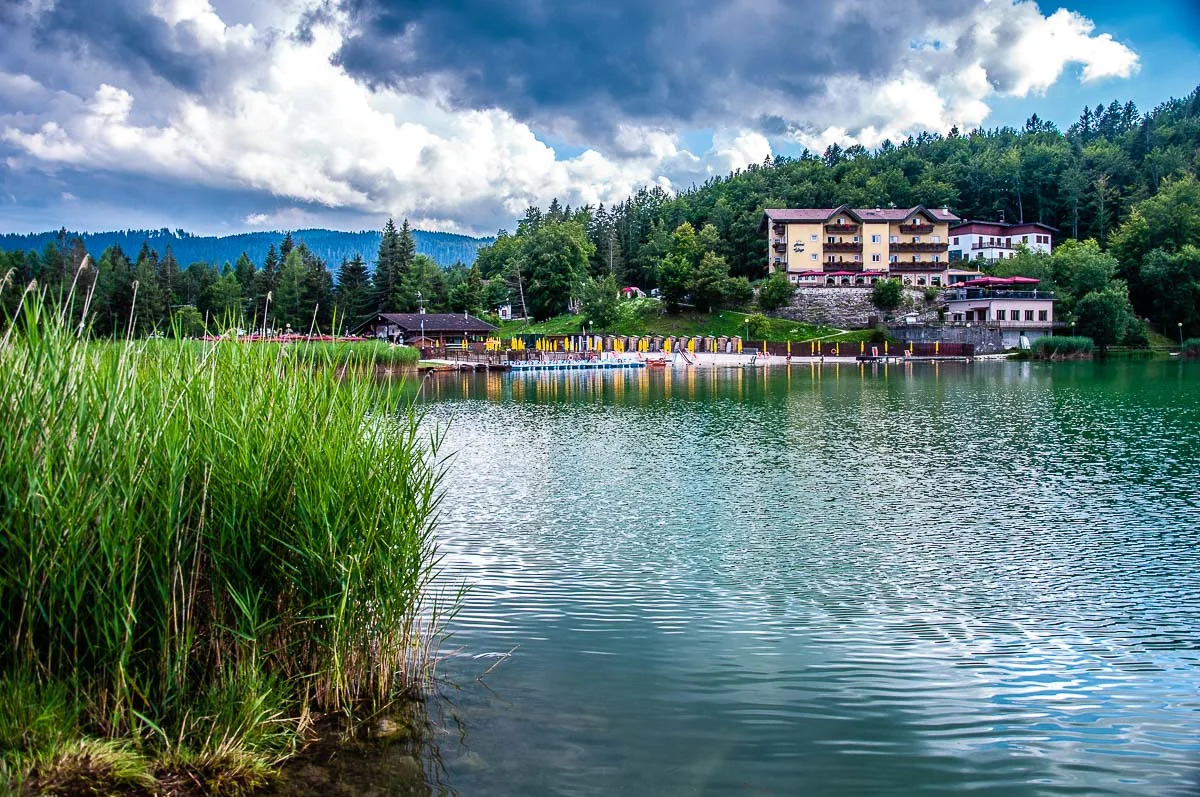
You can easily reach Trentino from Veneto, Lombardy, and Alto Adige. There are good road connections between the main cities here. In general, the road network in Trentino is well developed and maintained.
You can also use trains and buses. For example, there is a direct train from Verona in the Veneto to Trentino’s capital city – Trento. The same train line also connects Verona to the town of Ala and the city of Rovereto in Trentino.
In terms of major airports in Northern Italy, Verona Airport is very convenient for Trentino. For more details, please, have a look at this blog post:
3. When is the best time to visit Trentino, Italy?
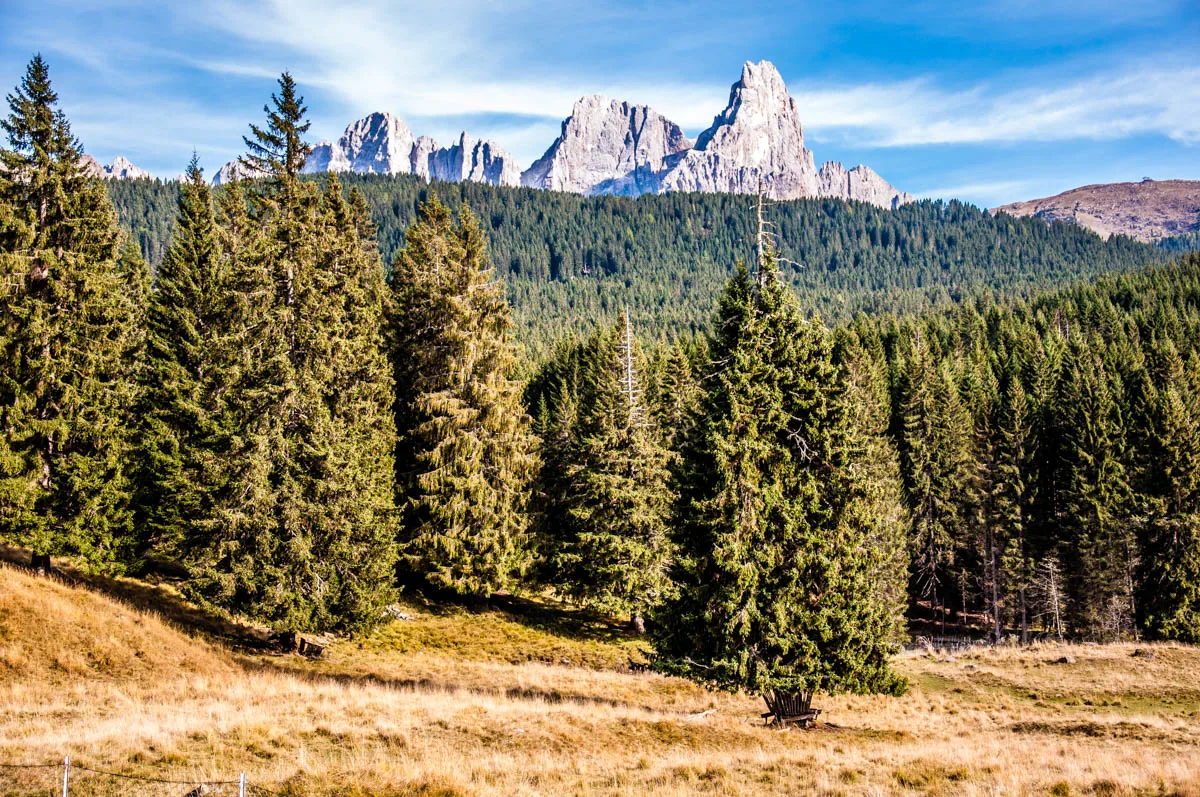
Trentino in Italy is a great year-round destination. In summer, people flock here to hike, be close to nature, and relax. With its lush forests, mountainous landscapes, and fresh air Trentino is a great place to be while the rest of Italy is scorching hot. In winter, skiing, snowboarding and other snow sports are the order of the day here.
4. Where to stay in Trentino, Italy?
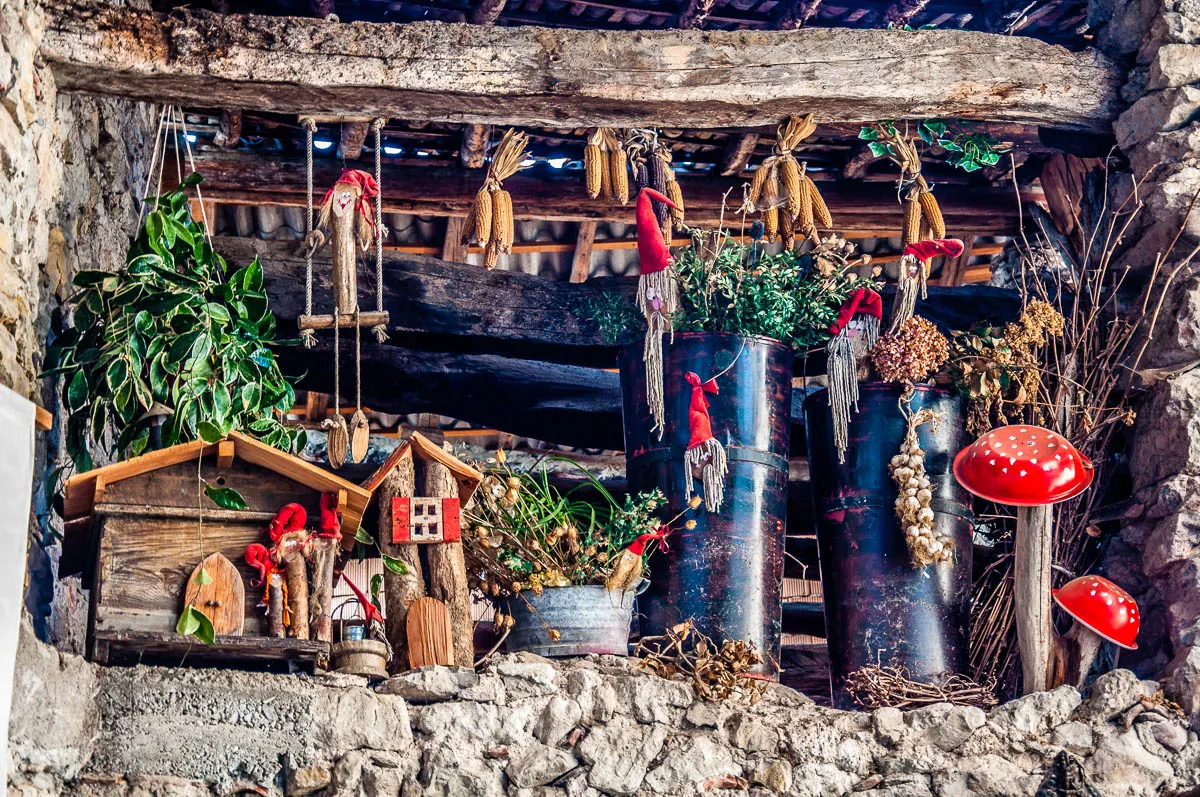
You can find all sorts and types of accommodation in Trentino, Italy to suit every budget. From five-star hotels to budget camping sites, there is something for everyone. Apart from the traditional hotels and B&B’s, here you can also stay in a mountain hut, a spa resort or a rustic house for a one-in-a-lifetime experience.
For ideas about the types of accommodation available in Trentino in particular and Italy in general, have a look at this blog post:
This map gives you a quick visual idea of the price ranges of the many hotels and other forms of accommodation you can book for your stay in Trentino in Italy. You can zoom in and out in order to search for a place to stay. You can also click on the option that interests you to find out more details or to make a booking.
If you click on ‘Accommodation’ in the top right corner and select ‘Experiences’ from the drop-down menu, then you can see some truly exciting experiences you can book directly:
5. What are some amazing places you can visit in Trentino, Italy?
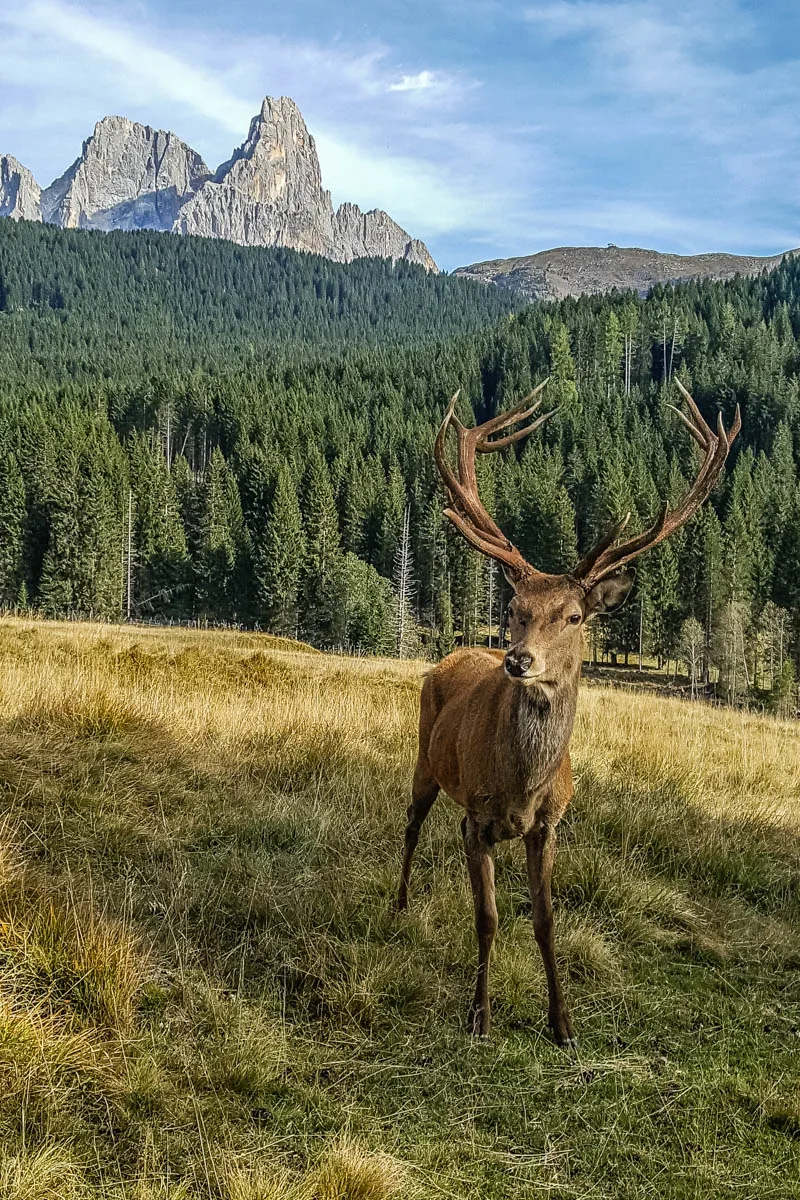
Trentino is small in size, yet it packs lots of surprises. There is lots to see and do here! Have a look at this blog post for some great ideas:
In Conclusion
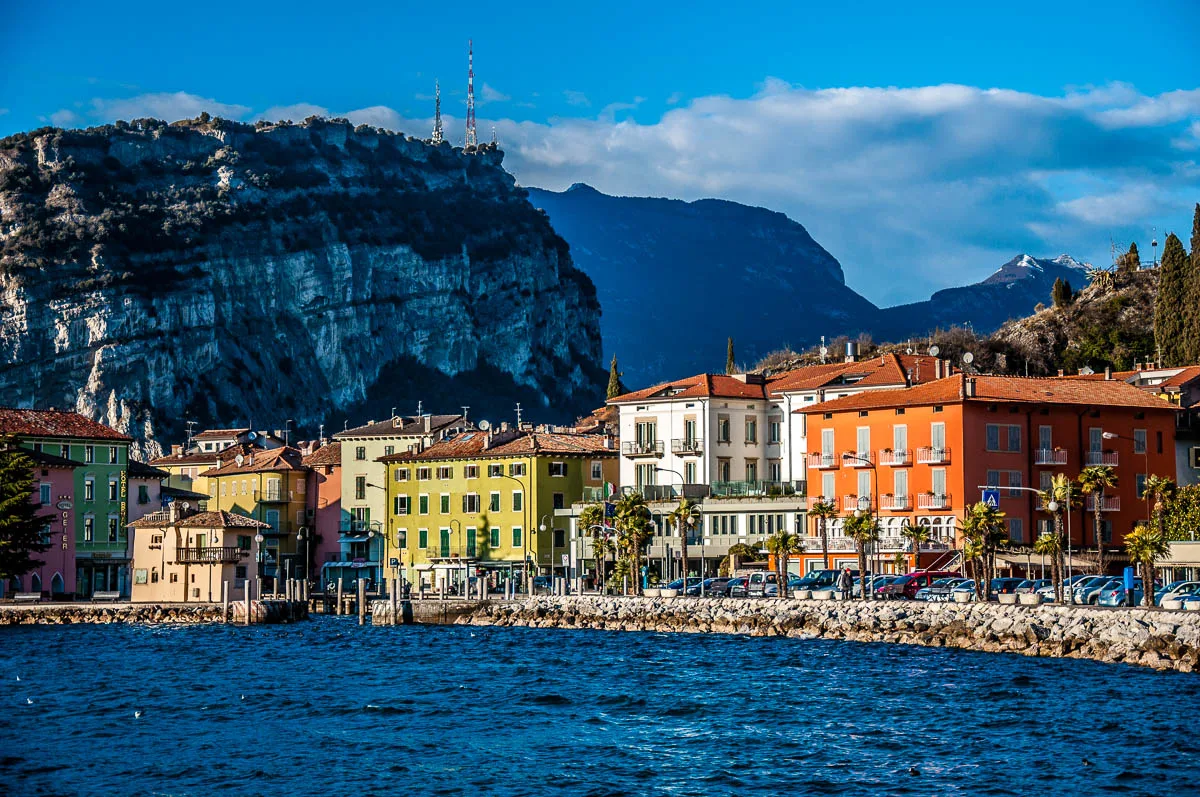
Trentino is an autonomous province in the north of Italy. It’s famous for its unspoilt nature, almost 300 lakes, and deep layers of history. It stays off the beaten tourist track and it’s a place to head to when you need peace and quiet as well as to stay active.
In the above blog post, I have listed ten of the best cities and towns to visit in Trentino, Italy. From the provincial capital Trento to hidden gems like Arco and famous ski resorts like San Martino di Castrozza, there are many destinations here to explore and fall in love with.
Free from the maddening crowds that besiege Italy’s famous tourist magnets and yet offering a long list of things to do and enjoy, these ten cities and towns in Trentino are a great destination for an Italian holiday. Surrounded by lush nature, they offer the ideal combination of city comforts, active exploration, and full relaxation.
I hope that this blog post will galvanise you to discover the cities and towns of Trentino for yourself.
Enjoy your stay in Trentino, Italy!
More Helpful Trentino Info for You
Trentino: 15 Amazing Places, Rovereto, Lakes in Trentino, Lake Caldonazzo, Paneveggio and Pale di San Martino
More Helpful Italy Info for You
Day Trips in Italy: Bologna to Venice, Milan to Verona, Venice to Verona, Milan to Venice, Florence to Venice, Verona to Venice, Venice to Padua
Best of Italy: Italian Piazzas, Italian Food, Italian Markets, Italian Coffee Culture
Northern Italy: 18 Best Cities to Visit
Lake Garda: Best Towns, Nearest Airports, Travel Options, Lake Garda with Kids
Lake Como: Things to See, Nesso
Veneto: Best Cities to Visit, Top 15 Places, 30 Adventures, 15 Most Colourful Places
Friuli Venezia Giulia: Venzone, Most Beautiful Villages
Emilia Romagna: Bologna, Ravenna, Comacchio, Most Beautiful Villages
Marche: 6 Reasons to Visit, Gradara, Frasassi Caves, Temple of Valadier
Venice: Essential Tips, Hidden Gems, Best Airports, Boats in Venice, Haunted Venice, Day Trips from Venice, Arco del Paradiso
Verona: Things to Do in One Day, Verona Opera Festival, Day Trips from Verona
Padua: Things to Do in One Day, 101 Facts About Padua, 10 Reasons to Visit Padua, Day Trips from Padua
Vicenza: Things to Do, Day Trips from Vicenza
Thank you for reading! Please, leave me a comment, pin the image below or use the buttons right at the top and at the end of this blog post to share it on social media.
For more useful information like this, please, like my blog’s page on Facebook and subscribe to my strictly no-spam newsletter.

